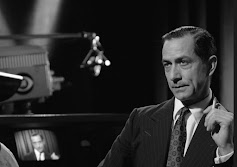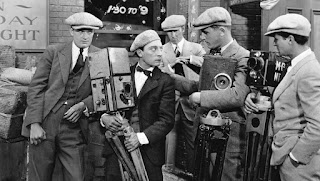"Silenced Screams"
Broadcast Journalism in the 1950s should have been a time for America’s breakthrough in live reports on television; however, censorship was on the prowl more than ever before. Good Night and Good Luck is a movie depicting and illustrating journalists fighting for their unalienable rights as citizens and as American reporters against McCarthyism's accusations of communism.

Journalists' role in society is to report the truth by presenting facts to the American people. These “Red Scare” issues at the beginning of the broadcasting television era are prevalent in today’s modern-day newsrooms. This is an era I would give the name “McCarthy’s Screams and Journalists Silence.”
Senator Joeseph McCarthy and his political agenda accused journalists of being communists. He wrongfully accused journalists of disagreements over the government’s policies. Journalists were forced to choose what was more valuable to them, their reputation, or the truth. Arguments against the government meant that a journalist needed to be silenced instead of seen as a hero.
Edward R. Murrow was a well-known broadcasting name who was a news anchor on Good Night and Good Luck. Joseph McCarthy was against communism, yet anyone who was against him was in trouble. The truth should be information that belongs in the hands of the public for them to form their own opinions and make informed decisions.
The case that would be an ongoing battle between the press and McCarthy was about a man named Milo Radulovich. An Air Force officer in the United States Military was fired for the accusations about his sister and father being communists because they read a Serbian newspaper. A man, willing to risk his life and fight for a citizen, even McCarthy was wrongfully convicted as a madman.
Murrow and the journalists working on his broadcasting segment wanted to share how these governmental accusations were false. The military wanted to approve the news segment on CBS News about Milo Radulovich. This created a News Blackout that meant the government was trying to censor any argument against McCarthy and his political party.
News reporters were being censored. News anchors had to sacrifice their positions to stick up for their beliefs and values. Murrow’s boss believed that McCarthy would self-destruct, but if Murrow does not tell the truth, then who will? The act of sandbagging was not an option for him as he was a loyal American Patriot.
In 1954 Murrow broadcast a segment about McCarthy stating that American people should know the facts. Reporters take an oath and should be guaranteed their rights to freely speak and write. After his segment ran, many reporters viewed Murrow as a symbol. They saw Murrow as the spark to ignite civil arguments against McCarthy.
After the uproar, Radulovich was reinstated and was no longer seen as a communist threat. On April 6th McCarthy wanted to appear on Murrow’s broadcast in hopes that him being a powerful senator would defeat what he called a know-nothing journalist. His main argument was that Murrow was the main leader of the communist party.
CBS News fell into the chilling situation where they feared legal accusations against Edward R. Murrow’s news broadcasts. Bill, the boss, moved his segment from Tuesday to Sunday afternoons in hopes of protecting their reputation rather than protecting their loyal and most trusted journalist.
Edward R. Murrow shared factual information to the public on Good Night and Good Luck to bring awareness and attention to the American public. McCarthy was the one making hasty communist accusations however, he was depicting himself just like a communist leader. As an aspiring journalist, this movie Good Night and Good Luck meant that journalists have a right to disagree, a right to speak out, and a right not to be controlled. Our government has the responsibility to protect these rights.
The same issues seen in Good Night and Good Luck occur today across various news networks. The government tries to promote and control certain political parties while censoring and hiding others. As journalists, we should be outraged. However, as American Citizens, we need to advocate and remember we can form our own opinions and hold true to our values and beliefs.
The press can question the government. They can speak out about the government if it is crossing the boundaries of our rights. A name I give to this Modern Era is “Silenced Screams,” because many news reporters chose to keep their reputations rather than go against the government. What would the journalism world look like if all reporters, broadcasters, and anchors told the truth? “That’s all folks… Good Night and Good Luck!”












